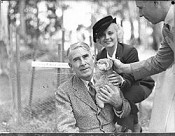Grey Zane

Zane Grey (January 31, 1872 – October 23, 1939) was an American author best known for his popular adventure novels and stories that presented an idealized image of the rugged Old West. As of June 2007, the Internet Movie Database credits Grey with 110 films, one TV episode, and a series, Dick Powell's Zane Grey Theater based loosely on his novels and short stories. Pearl Zane Gray was born January 31, 1872 in Zanesville, Ohio. He was the fourth of five children born to Lewis M. Gray, a dentist, and his wife, Alice "Allie" Josephine Zane, whose Quaker ancestor Robert Zane came to America in 1673 from England.[1] His family changed the spelling of their last name to Grey after his birth. Later Grey used Zane as his first name. Grey grew up in Zanesville, a city founded by his maternal ancestor Ebenezer Zane, a Revolutionary War patriot, so he felt surrounded by history. Grey developed interests in fishing, baseball, and writing, all which contributed to his writing success.[2] His first three novels memorialized the heroism of his Revolutionary relatives.[3] As a child, Grey frequently engaged in violent brawls. His father punished him with severe beatings. Though irascible and antisocial like his father, Grey was supported by a loving mother and had a father substitute. Muddy Miser was an old man who approved of Grey's love of fishing and writing, and who talked about the advantages of an unconventional life. Despite warnings by Grey’s father to steer clear of Muddy, Grey spent five formative years in the company of the old man.[4] Grey was an avid reader who stoked his imagination with adventure stories (Robinson Crusoe and Leatherstocking Tales) and dime novels (featuring Buffalo Bill and "Deadwood Dick"). He was enthralled by and crudely copied the great illustrators Howard Pyle and Frederic Remington.[5] He was particularly impressed with Our Western Border, a history of the Ohio frontier which likely inspired his earliest novels.[6] Zane wrote his first story, Jim of the Cave, when he was fifteen. His father tore it to shreds and beat him.[7] Both Grey and his brother Romer were active, athletic boys who were enthusiastic baseball players and fishermen.[8] A severe financial setback in 1889 caused by a poor investment forced Grey's father, out of embarrassment, to move his family out of Zanesville to start anew in Columbus, Ohio.[9] His father struggled to re-establish his dental practice. Grey helped by making rural house calls and performing basic extractions, which he had learned from his father. He practiced until the state board intervened. Romer helped out by driving a delivery wagon.[10] Grey also worked as a part-time usher in a movie theater and played summer baseball for the Columbus Capitols, with aspirations of becoming a major leaguer.[11] Eventually, Grey was spotted by a baseball scout and received offers to many colleges. Romer also attracted attention and went on to have a pro-baseball career.[10] Grey chose the University of Pennsylvania on a baseball scholarship, where he studied dentistry and joined Sigma Nu fraternity; he graduated in 1896. When he arrived at Penn, he had to prove himself worthy of a scholarship before receiving it. He rose to the occasion by coming in to pitch against the Riverton club, pitching five no-run innings and producing a double in the tenth which contributed to the win.[12] The Ivy League was highly competitive and an excellent training ground for future pro baseball players. Grey was a solid hitter and an excellent pitcher who relied on a sharply dropping curve ball. When the distance from the pitcher's mound to the plate was lengthened by ten feet in 1894 (primarily to reduce the dominance of Cy Young’s pitching), the effectiveness of Grey’s pitching suffered. He was re-positioned to the outfield.[13] The short, wiry baseball player remained a campus hero on the strength of his timely hitting.[14] He was an indifferent scholar, barely achieving a minimum average. Outside class he spent his time on baseball, pool, and creative writing, especially poetry.[12] His shy nature and his teetotaling set him apart and he socialized little. Grey struggled with the idea of becoming a writer or baseball player for his career, but unhappily concluded that dentistry was the practical choice. During a summer break, while playing 'summer nines' in Delphos, Ohio, Grey was charged with, and quietly settled, a paternity suit. His father paid the $133.40 cost and Grey resumed playing summer baseball in Delphos. He managed to conceal the episode when he returned to Penn.[15] Grey went on to play minor league baseball with a team in Newark, New Jersey and also with the Orange Athletic Club for several years. His brother, Romer Carl "Reddy" Grey (known as "R.C." to his family) did better and played professionally in the minor leagues. He played a single major league game in 1903 for the Pittsburgh Pirates.[16] After graduating, Grey established his practice in New York City under the name of Dr. Zane Grey in 1896. It was a competitive area but he wanted to be close to publishers. He began to write in the evening to offset the tedium of his dental practice.[17] He struggled financially and emotionally. Grey was a natural writer but his early efforts were stiff and grammatically weak. Whenever possible, he played baseball with the Orange Athletic Club in New Jersey, a team of former collegiate players that was one of the best amateur teams in the country.[17] Grey often went camping with his brother R.C. in Lackawaxen, Pennsylvania, where they fished in the upper Delaware River. When canoeing in 1900, Grey met seventeen year-old Lina Roth, better known as "Dolly". They married five years later. Dolly came from a family of physicians and was studying to be a schoolteacher.[18] They had a passionate and intense courtship, but quarreled frequently. Grey suffered bouts of depression, anger, and mood swings, which affected him most of his life. As he described it, “A hyena lying in ambush—that is my black spell! I conquered one mood only to fall prey to the next…I wandered about like a lost soul or a man who was conscious of imminent death."[19] During his courtship with Dolly, Grey was still in contact with previous girlfriends and warned her frankly, "But I love to be free. I cannot change my spots. The ordinary man is satisfied with a moderate income, a home, wife, children, and all that….But I am a million miles from being that kind of man and no amount of trying will ever do any good". He added, "I shall never lose the spirit of my interest in women."[20] When they married in 1905, Dolly gave up her teaching career. They moved to a farmhouse at the convergence of the Delaware and Lackawaxen rivers, in Lackawaxen, Pennsylvania, where Grey's mother and sister joined them. (This historic house is preserved as the Zane Grey Museum.) Grey finally ceased his dental practice to devote full-time to his nascent literary pursuits. Dolly’s inheritance provided an initial financial cushion.[21] While his wife managed his career and raised their three children, over the next two decades Grey often spent months away from them. He fished, wrote and spent time with his many mistresses. While Dolly knew of his behavior, she seemed to view it as his handicap rather than a choice. Throughout their life together, he highly valued her management of his career and their family, and her solid emotional support. In addition to her considerable editorial skills, she had good business sense and handled all his contract negotiations with publishers, agents, and movie studios. All his income was split fifty-fifty with her; from her "share", she covered all family expenses.[22] Their considerable correspondence shows evidence of his lasting love for her despite his indiscretions and personal emotional turmoil. The Greys moved to California in 1918. In 1920 they located in Altadena, California, where Grey bought a prominent mansion on East Mariposa Street, known locally as "Millionaire's Row". Designed by architects Myron Hunt and Elmer Grey (no relation to the author), the 1907 Mediterranean style house is acclaimed as the first fireproof home in Altadena, built entirely of reinforced concrete as prescribed by the first owner's wife. Grey summed up his feelings for Altadena with this quote: "In Altadena, I have found those qualities that make life worth living." (The city uses it in promotions.) With the help of Dolly’s proofreading and stylistic corrections, Grey gradually improved his style. His first magazine article, A Day on the Delaware, a human-interest story about a Grey brothers’ fishing expedition, was published in the May 1902 issue of Recreation magazine.[23] He was elated by selling the article, and he offered reprints to patients in his waiting room.[24] In writing, Grey found temporary escape from the harshness of his life and his demons. “Realism is death to me. I cannot stand life as it is.”[25] By this time, he had given up baseball.[26] Grey read Owen Wister’s great Western novel The Virginian. After studying its style and structure in detail, he decided to write a full-length story.[25] Grey's first novel, Betty Zane (1903), was a torment to write. When it was rejected by Harper & Brothers, he lapsed into despair.[27] The novel dramatized the heroism of his ancestor who had saved Fort Henry. He self-published it, perhaps with funds provided by R. C.'s wealthy girlfriend Reba Smith or his wife Dolly.[28] From the beginning, vivid description was the strongest aspect of his writing.[29] After attending a lecture in New York in 1907 by C. T. "Buffalo" Jones, famed western hunter and guide, Grey arranged for a mountain lion-hunting trip to the North rim of the Grand Canyon.[30] He brought along a ‘portable’ camera to document his trips and prove his adventures. He also began the habit of taking copious notes, not only of scenery and activities but of dialogue as well.[31] His first two trips were arduous, but Grey learned much from his rough compatriot adventurers. He gained the confidence to write convincingly about the West, its characters, and its landscape. Treacherous river crossings, unpredictable beasts, bone-chilling cold, searing heat, parching thirst, bad water, irascible tempers, and heroic cooperation all became real to him. He wrote, “Surely, of all the gifts that have come to me from contact with the West, this one of sheer love of wildness, beauty, color, grandeur, has been the greatest, the most significant for my work.”[32]
do you like this author?
What readers are saying
What do you think? Write your own comment on this book!
write a commentWhat readers are saying
What do you think? Write your own comment on this author!
write a commentBook list

The Young Pitcher
Series:
Unknown
Year:
Unknown
Raiting:
5/5
A book by an American author, considered by right to be a founder of an adventure western novel as a genre. The two thirds of his works are devoted to an idealized image of the Old West. However, “The Young Pitcher” is a baseball story of Ken Ward, who gains recognition with his pitching skills. A professional baseball player in his past, Zane Grey created one of the books for boys.
Show more
add to favoritesadd In favorites
Book list

The Young Pitcher
Series:
Unknown
Year:
Unknown
Raiting:
5/5
A book by an American author, considered by right to be a founder of an adventure western novel as a genre. The two thirds of his works are devoted to an idealized image of the Old West. However, “The Young Pitcher” is a baseball story of Ken Ward, who gains recognition with his pitching skills. A professional baseball player in his past, Zane Grey created one of the books for boys.
Show more
add to favoritesadd In favorites

Tales of lonely trails
Series:
Unknown
Year:
Unknown
Raiting:
1.5/5
Tales of lonely trails is a collection of stories, legends and tales collected by Zane Grey which is mix of various genres including poetry, fiction, nonfiction, comedy, drama and many others. Most of the story are devoted to the history of American West and its history. The stories give its readers a detailed insight into the daily life of the contemporary society, the settlers there and the enthusiasts of the American West. The book would definitely appeal to readers who want to learn the new sides of the culture of the West.
Show more
add to favoritesadd In favorites

Tales of Fishes
Series:
Unknown
Year:
Unknown
Raiting:
5/5
Purchase of this book includes free trial access to www.million-books.com where you can read more than a million books for free. This is an OCR edition with typos. Excerpt from book: Ill THE ROYAL PURPLE GAME OF THE SEA TO the great majority of anglers it may seem unreasonable to place swordfishing in a class by itselfby far the most magnificent sport in the world with rod and reel. Yet I do not hesitate to make this statement and believe I can prove it. The sport is young at this writingvery little has been written by men who have caught swordfish. It was this that attracted me. Quite a number of fishermen have caught a swordfish. But every one of them will have something different to tell you and the information thus gleaned is apt to leave you at sea, both metaphorically and actually. Quite a number of fishermen, out after yellowtail, have sighted a swordfish, and with the assistance of heavy tackle and their boatmen have caught that swordfish. Some few men have caught a small swordfish so quickly and easily that they cannot appreciate what happened. On the other hand, one very large swordfish, a record, was caught in an hour, after a loggy rolling about, like a shark, without leaping. But these are not fighting swordfish. Of course, under any circumstances, it is an event to catch a swordfish. But the accidents, the flukes,the lucky stabs of the game, do not in any sense prove what swordfishing is or what it is not. In August, 1914, I arrived at Avalon with tuna experience behind me, with tarpon experience, and all the other kinds of fishing experience, even to the hooking of a swordfish in Mexico. I am inclined to confess that all this experience made me well, somewhat too assured. Any one will excuse my enthusiasm. The day of my arrival I met Parker, the genial taxidermist of Avalon, and I started to tell him how I wanted my swordfish mounted. He interrupted me: "Say, young fellow, you want to catch a swordfish first!" One of the tuna boat...
Show more
add to favoritesadd In favorites

The Rustlers of Pecos County
Series:
Unknown
Year:
Unknown
Raiting:
1/5
Zane Grey was an American author best known for his adventure novels and pulp fiction that glamorized the Old West. Grey became one of the first millionaire authors. He would spend part of the year traveling having adventures and the rest of the year using his experiences to create his fiction. The Rustlers of Pecos County is a novel of adventure, action, and romance set in Texas. The story follows two rangers who attempt to clean out the ruthless rustlers who infiltrate the Texas Rangers.
Show more
add to favoritesadd In favorites

The Lone Star Ranger, a romance of the border
Series:
Unknown
Year:
Unknown
Raiting:
4/5
1914. Illustrated. From the master of the western comes a novel full of romance and adventure. The story begins: So it was in him, then-an inherited fighting instinct, a driving intensity to kill. He was the last of the Duanes, that old fighting stock of Texas. But not the memory of his dead father, nor the pleading of his soft-voiced mother, nor the warning of this uncle who stood before him now, had brought to Buck Duane so much realization of the dark passionate strain in his blood. It was the recurrence, a hundred fold increased in power, of a strange emotion that for the last three years had arisen in him. See other titles by this author available from Kessinger Publishing. --This text refers to the Paperback edition.
Show more
add to favoritesadd In favorites
What readers are saying
What do you think? Write your own comment on this author!
write a commentGenre
- Books
- Books / Biographical fiction
- Nonfiction / Politics / General
- Literature & Fiction
- Literature & Fiction / Genre Fiction / Westerns / General
- Books / Hermits of Bethlehem of the Heart of Jesus / Rules
- Law / United States
- Nonfiction / Education / Education Theory / History
- Books / California / Description and travel
if you like Grey Zane try:
readers also enjoyed
What readers are saying
What do you think? Write your own comment on this author!
write a commentGenre
- Books
- Books / Biographical fiction
- Nonfiction / Politics / General
- Literature & Fiction
- Literature & Fiction / Genre Fiction / Westerns / General
- Books / Hermits of Bethlehem of the Heart of Jesus / Rules
- Law / United States
- Nonfiction / Education / Education Theory / History
- Books / California / Description and travel
if you like Grey Zane try:
readers also enjoyed
Do you want to read a book that interests you? It’s EASY!
Create an account and send a request for reading to other users on the Webpage of the book!



